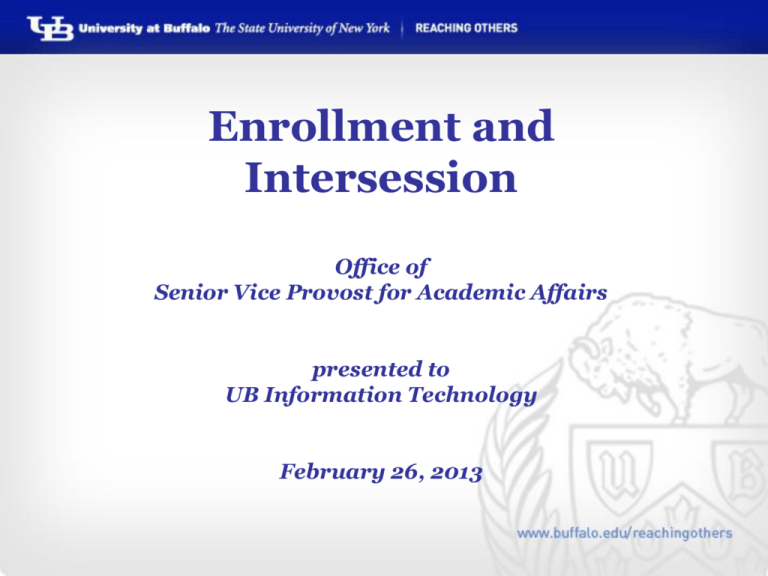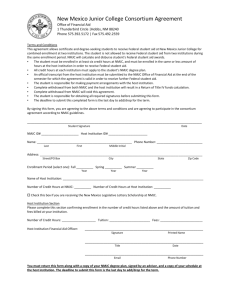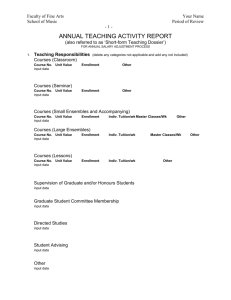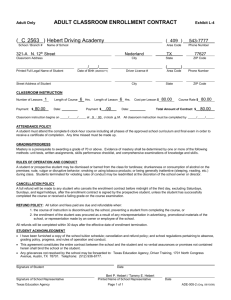undergraduate enrollment
advertisement

Enrollment and Intersession Office of Senior Vice Provost for Academic Affairs presented to UB Information Technology February 26, 2013 Structure of Our Conversation • Importance of enrollment and building a culture that embraces a shared responsibility • Why intersession? • Impact to academic calendar • Course offerings • Next steps • Questions? 2 Enrollment Challenges on the Horizon and Budget Implications • • • • • • 3 Changing budget model based on enrollment Current enrollment shortfall We are in a demographic downturn Transfer pipeline eroding We want to increase graduation rates QUESTIONS • Can freshman class grow in size without losing quality to preserve stable undergraduate enrollments? • Can non-resident enrollments increase? FINANCIAL CONTEXT State Tax Funds Plus UB Tuition Revenue $ in millions 220 214 STATE TAX $ 200 184 211 203 206 182 181 180 167 167 156 140 130 120 100 134 140 135 149 149 2011/12 2012/13 145 TUITION $ 100 2002/03 4 194 176 153 160 180 2003/04 2004/05 2005/06 2006/07 2007/08 2008/09 Source: Financial Services 2009/10 2010/11 REVENUE PER STUDENT UNDER NEW SUNY BUDGET MODEL Tuition, Fees & State Support 5 Source: Estimates based on enrollment patterns of students in majors, Fall 2011. UNDERGRADUATE ENROLLMENT 15,000 14,000 13,000 12,000 11,000 10,000 5,000 4,000 3,000 2,000 1,000 0 Current PLAN Submitted Plan 13,170 13,060 13,264 12,999 13,075 13,075 13,075 12,849 13,020 13,035 12,645 12,702 3,215 3,170 3,389 3,184 3,166 3,197 3,157 3,071 1,695 1,731 1,718 1,786 1,897 1,824 1,930 1,748 3,416 3,265 3,265 3,265 1,731 1,955 1,955 1,955 2004 2005 2006 2007 20082009 2010 2011 2012 2013 2014 2015 Freshman Transfer Source: Official Enrollment, includes full- and part-time regular enrollment. 6 Continuing/Returning PROJECTED NYS HIGH SCHOOL GRADUATES High school graduates projected to decline ~7% through 2020 181,604 176,228 171,846 171,384 170,313 166,975 2012 7 2013 2014 2015 2016 168,312 167,726 2017 2018 168,169 2019 2020 SUNY COMMUNITY COLLEGE Freshman Enrollments 50,000 48,000 46,135 46,773 46,000 44,161 42,740 44,000 40,000 38,000 41,500 41,094 42,000 38,886 37,468 37,090 36,000 34,000 32,000 30,000 Fall 2004 Fall 2005 Fall 2006 Source: NYSED ORIS, First-time, Full-time Enrollments 8 Fall 2007 Fall 2008 Fall 2009 Fall 2010 Fall 2011 Fall 2012* *-preliminary estimate PROJECTED CHANGES IN HS GRADUATES FROM OTHER KEY STATES IL 0.5% NJ 0.3% CA -0.5% MD -1.0% OH -3.1% PA -6.0% MA -3.9% CT -5.3% FL -6.1% MI -10.1% 9 GRADUATE ENROLLMENT Current Submitted Plan Source: Official Enrollment, includes full- and part-time regular enrollment. 10 ONE-YEAR PERCENTAGE CHANGE IN NEW GRADUATE ENROLLMENTS 2011 FIELDS Arts & Humanities Biological Sciences & Agriculture Business Education Engineering Health Sciences Math and Computer Science Physical & Earth Sciences Public Administration Social & Behavioral Sciences Source: Council of Graduate Schools. 11 MASTER'S AND CERTIFICATE -5.5% 0.7% 2.7% -9.3% 0.4% 4.0% 0.6% 0.6% -0.1% 0.3% DOCTORAL -3.6% -1.9% -2.9% -4.0% 1.4% 17.5% 5.6% 0.4% 13.5% -2.4% Why intersession? • Opportunity to increase enrollment and revenue • Unique educational offerings that can focus on a single subject in small, intimate classes • Supports Finish in Four and improved graduation rates • More time between fall and spring for research, projects, and course preparation • Greater use of University facilities • Smoother spring semester start-up 12 Enrollment Potential Student Participation in Winter Session Year 2005 2006 2007 2008 2009 2010 2011 2012 Albany 170 315 480 762 822 Binghamton Stony Brook Buffalo 303 0 424 881 0 716 1274 0 790 1515 0 1023 1699 0 1326 1959 0 1264 2058 0 1282 2237 0 Assuming 3 credits per course and an average tuition rate of $300/credit would yield about $2M in tuition revenue for Stony Brook in 2012. 13 Impact on Academic Calendar Comparison of Academic Calendars with and without Intersession 2014 Calendar Year 14 Credit Hour Requirements 14 class days Credits 1 2 3 4 5 Contact hours per day 55 minutes 1 hour, 2 hours, 3 hours, 4 hours, 50 minutes 45 minutes 40 minutes 30 minutes Outside student preparation expected per day 2 hours, 4 hours, 6 hours, 8 hours, 10 hours, 10 minutes 20 minutes 30 minutes 40 minutes 50 minutes Additional contact hours may be substituted for preparation hours, but not vice versa. 15 Course Offerings Opportunity for innovative, engaging teaching and research • Intensive language study • Study Abroad • Re-envisioned General Education courses • Undergraduate research experiences • Capstone design experience • “Boot camps” • Distance learning • Immersion-style courses • Internships • Field research The Academic Offerings sub-committee is developing recommendations, and is looking for participants. 16 Next Steps Committees assembled to explore implications and propose implementation plans • Academic Calendar and Faculty Advisory Group • Academic Offerings • Communications and Marketing • Financials • Records and Registration • University Services 17 Questions 18





